| Srl | Item |
| 1 |
ID:
114643
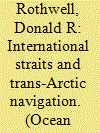

|
|
|
|
|
| Publication |
2012.
|
| Summary/Abstract |
The Arctic Ocean is increasingly becoming accessible to international shipping as a result of the reduction in Arctic sea ice. Commercial shipping may seek to transit the Arctic Ocean from either the Pacific or Atlantic Ocean and, as a result, the legal regime of straits has significance for trans-Arctic navigation. In this article, current developments in Arctic shipping are assessed and consideration is given to certain Arctic straits that could prove to be pivotal in future Arctic navigation and shipping. These straits include the Bering Strait, Nares Strait, Davis Strait, Fram Strait, and Denmark Strait.
|
|
|
|
|
|
|
|
|
|
|
|
|
|
|
|
| 2 |
ID:
108733
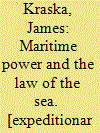

|
|
|
|
|
| Publication |
Oxford, Oxford University Press, 2011.
|
| Description |
xix, 464p.
|
| Contents |
Includes bibliographal references and index.
|
| Standard Number |
9780199773381
|
|
|
|
|
|
|
|
|
|
|
|
Copies: C:1/I:0,R:0,Q:0
Circulation
| Accession# | Call# | Current Location | Status | Policy | Location |
| 056383 | 341.448/KRA 056383 | Main | On Shelf | General | |
|
|
|
|
| 3 |
ID:
121480
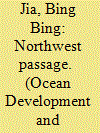

|
|
|
|
|
| Publication |
2013.
|
| Summary/Abstract |
This article uses the Northwest Passage as a case for study of one issue relating to the regime of international straits: whether a strait formed geographically and functionally by means of artificial aids for navigation may be regarded as an artificial waterway to which the regime of international straits does not apply. The article suggests that the Northwest Passage could be subject to a bilateral treaty regime between Canada and the United States, largely akin to that which applies to artificial waterways such as the Panama Canal. This solution would guarantee both Canadian sovereignty over the Passage and the interests of international shipping in having a route open and secure.
|
|
|
|
|
|
|
|
|
|
|
|
|
|
|
|
| 4 |
ID:
118011
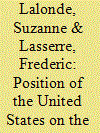

|
|
|
|
|
| Publication |
2013.
|
| Summary/Abstract |
For decades, Ottawa and Washington have been agreeing to disagree on the question of the legal status of the Northwest Passage. One argument which has been consistently raised on the U.S. side and which has precluded attempts to end the deadlock has been the fear of creating a negative precedent. This article assesses whether U.S. concerns are warranted: could coastal States elsewhere in the world rely on an eventual recognition of Canadian sovereignty over the Northwest Passage to bolster their claims over a local strait?
|
|
|
|
|
|
|
|
|
|
|
|
|
|
|
|
| 5 |
ID:
133069
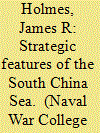

|
|
|
|
|
| Publication |
2014.
|
| Summary/Abstract |
The South China Sea is a semienclosed sea at the intersection between East Asia and the Indian Ocean region. It exhibits characteristics similar to the Mediterranean Sea and the Caribbean Sea, as well as some revealing differences. Both the similarities and the differences commend sea-power theorist Alfred Thayer Mahan's analysis of the Gulf of Mexico and the Caribbean Sea to presentday students and practitioners of maritime strategy. Mahan classified strategic features-especially prospective sites for naval stations-by their positions, strengths, and resources. This article adds a metric to his analytical template, namely, the state of relations with countries that host naval bases. He applied much the same framework to narrow seas, such as international straits, while also sizing up these passages' widths, lengths, and difficulty of transit. Here too an element warrants adding, namely, the underwater terrain-its topography and hydrography.
|
|
|
|
|
|
|
|
|
|
|
|
|
|
|
|